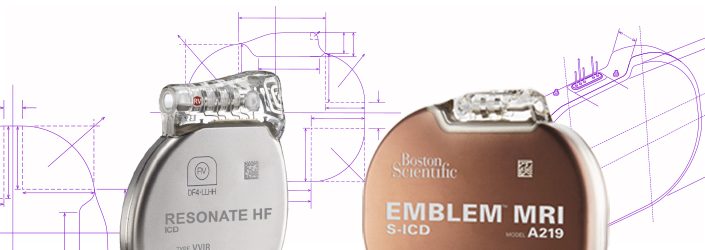
Discover how your ICD or S-ICD system works to monitor and treat dangerously fast ventricular heart rhythms so you can live a more active life.
What is an ICD?
An implantable cardioverter defibrillator, commonly known as an ICD, is a device designed to administer lifesaving therapy in the event of a sudden cardiac arrest (SCA). When the ICD senses a dangerously high heart rate, it will send an electrical pulse to your heart to reset its normal rhythm and allow your heart to resume pumping blood through your body. This is known as defibrillation. ICDs have been used for decades and have prolonged hundreds of thousands of lives.
Types of ICDs
There are two types of ICDs being implanted today:
- Transvenous ICD systems, also known as TV-ICDs
- Subcutaneous ICDs, such as the EMBLEM™ S-ICD
Both types of ICDs sense when the heart rate is dangerously fast and can deliver a shock to the heart to restore a normal heartbeat.
Transvenous ICD Implant Procedure
- A transvenous ICD device is typically implanted in the left shoulder area, near the collarbone.
- Using X-ray imaging, the leads are fed through a vein into the heart and across the heart valve.
- Depending on your heart condition, one or two leads will be placed in the heart. Once the leads are put in place, they are attached to the heart wall for optimal connectivity.
EMBLEM™ S-ICD Procedure
- Unlike a transvenous ICD device, the pulse generator in an S-ICD is typically implanted on the left side of the chest next to the rib cage and the lead is implanted just under the skin above the breastbone.
- The EMBLEM S-ICD electrode is placed under the skin and the system delivers therapy without the need for wires implanted in the heart.
- EMBLEM S-ICD leaves the heart and blood vessels untouched and intact.

An implanted transvenous ICD system.

An implanted subcutaneous ICD system.
Your ICD or S-ICD Battery
Just like any battery, the battery in your ICD or S-ICD will run out over time. Since the battery is permanently sealed inside your device, it can’t be replaced when its energy is depleted. So if your battery runs out, your entire device will need to be replaced. The battery life depends on the settings your doctor programs and how much therapy you receive.
Your ICD or S-ICD will regularly check its own battery. In addition, your doctor will check to see how much energy your battery has left at each follow-up visit.
ICD and S-ICD Implant Risks
While complications don’t happen very often, it’s important to know that there are risks associated with the implantation of any device or lead. You should talk with your doctor about these risks, including the ones below.
Some of the risks encountered during the implant procedure include, but are not limited to, the following:
- Bleeding
- Formation of a blood clot
- Damage to adjacent structures (tendons, muscles, nerves)
- Puncture of a lung or vein
- Damage to the heart (perforation or tissue damage)
- Dangerous arrhythmias
- Heart attack
- Stroke
- Death
Some of the risks encountered after the system is implanted may include, but are not limited to, the following:
- You may develop an infection
- You may experience erosion of the skin near your device
- The device may move from the original implant site
- The lead(s) may move out of place in the heart
- The electrodes on the lead or the pacing pulses may cause an irritation or damaging effect on the surrounding tissues, including heart tissue and nerves
- You may have difficulty coping with having an implanted device
- The device might be prevented from shocking or pacing due to electromagnetic interference
- You may receive a shock or pacing therapy when it is not needed
- The device might not be able to detect or appropriately treat your heart rhythms
- The device may exhibit malfunctions that may result in lost or compromised ability to deliver therapy
Be sure to talk with your doctor so that you thoroughly understand all the risks and benefits associated with the implantation of an ICD or S-ICD system.